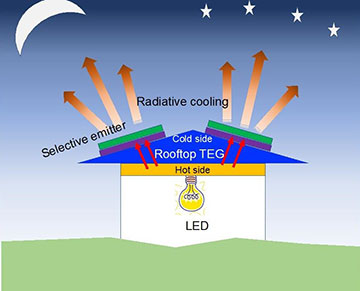
Researchers have designed an off-grid, low-cost modular energy source that uses radiative cooling and a thermoelectric power generator (TEG) to efficiently produce power for lighting at night. [Image: Lingling Fan and Wei Li, Stanford University]
At some point, nearly every solar-energy enthusiast has heard the question: “What happens when you need electricity at night?” A research team at a U.S. university has figured out a passive, efficient way to generate electrical energy after the sun sets (Opt. Express, doi: 10.1364/OE.397714).
The system proposed by scientists at Stanford University, USA, relies on radiative cooling of a thermoelectric generator (TEG)—a rooftop system with a temperature difference between its underside and the top side facing open space. According to the team, the system, based on existing technology, could achieve an electrical power density above 2 W/m2, well above previous experimental work.
Lighting up the dark
Obviously, the demand for electric lighting grows after nightfall, when sunlight stops falling on photovoltaic panels. Regions far from the equator also have seasons with long hours of darkness. The Stanford team noted that energy-storage systems can significantly drive up the cost of off-grid solar power, making it less affordable for residents of developing regions.
The researchers turned to thermoelectric power generation and analyzed the basic thermodynamics of a heat engine, with the hot side under the roof and the top of the roof radiating thermal energy out into the environment. They developed models to maximize the amount of electrical power generated for various temperature gradients.
The team’s design for a nighttime power generator would occupy a rooftop area of 1 m2. It incorporates a radiative emitting panel, a state-of-the-art TEG made of metal alloy, and a heat sink, with radiation shields and insulative pegs to reduce radiative and conductive losses on the back side.
The efficiency of a TEG is assessed by a dimensionless figure of merit called ZT, which is proportional to the generator’s electrical conductivity and temperature and inversely proportional to its thermal conductivity. The state-of-the-art TEG that the Stanford team modeled has a ZT of 6, though the group also modeled the results for a TEG with a “futuristic” ZT value of 60.
Off-grid and in reverse
The researchers, including lead author and Stanford graduate student Lingling Fan, are testing their proof-of-concept work experimentally. Fan says she hopes that the design could supply power to other off-grid devices such as agricultural, environmental and security sensors. Further, the team is investigating how thermoelectric generators could run in reverse, so to speak, to harvest power from sunlight or from waste heat given off by motor vehicles.
The research team included a Technion-Israel Institute of Technology, Israel, professor who served as a visiting scholar at Stanford.
